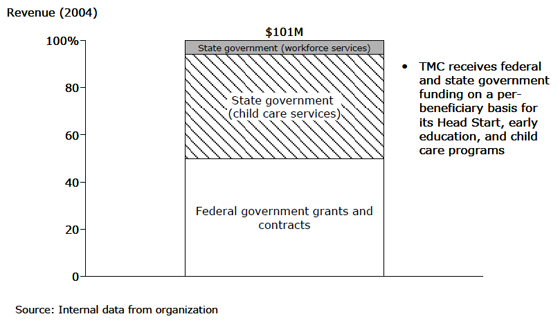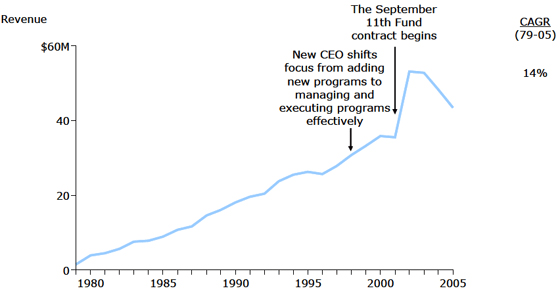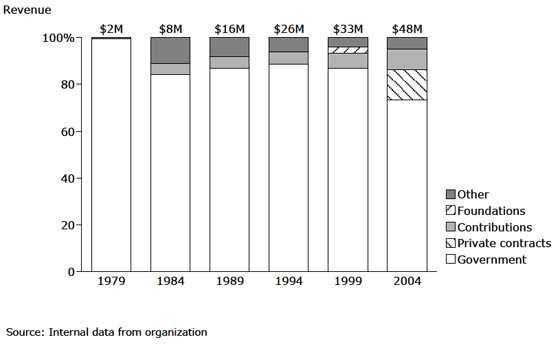We had to realize that our greatest resource was our expertise in early child education. We couldn't get sidetracked from this from a financial or mission perspective.
– Mary Capello, Chief Executive Officer
Overview
Related Content
How Nonprofits Get Really BigOrganization Profiles from How Nonprofits Get Really Big
Texas Migrant Council, Inc. (DBA, New America Corporation) (TMC or the “corporation”) was founded in 1971 as a Head Start provider for the children of migrant farm workers. Its program mirrored the migrant worker lifestyle, serving children and their families along the Texas-Mexico border for nine months out of the year and then shifting for the remaining three months to different parts of the country where the migrant families found agricultural work. TMC’s approach focuses on providing comprehensive services with a trained core of staff that are bilingual, bicultural, and sensitive to the plight of the migrant farm worker.
TMC currently administers federally-funded Head Start programs across eight states, serving 8,000 children ages birth through five years and their families in Ohio, Oklahoma, Wisconsin, Iowa, Indiana, Nevada, New Mexico, and Texas. The corporation also has developed expertise in early childhood education, child care, and workforce development, offering programming that is grounded in its expertise in outreach to migrant and Latino communities and in language- and culture-specific curricula.
Government contracts and grants have fueled TMC’s growth. The corporation has expanded the number of youth it serves by entering new geographies, establishing partnerships with other nonprofits, and building relationships with new funding agencies. TMC has worked hard to diversify its government funding sources; its state child care contracts are now nearly equal in size to its federal Head Start funds.
Founding date: 1971
Revenue (2004): $101 million
Structure: Single organization
NCCS classification: Education, elementary & secondary schools
Services: Operates migrant and seasonal Head Start programs; also offers workforce training, early education, and childcare services
Beneficiaries: Latino youth in migrant families in 70 communities in Texas, Ohio, Indiana, Wisconsin and New Mexico; non-migrant youth and adults in Texas
Leadership (selected): Mary Capello, Chief Executive Officer; Jerald Sparenburg, Chief Financial Officer
Address: 5215 McPherson Road, Laredo, TX 78041
Website: www.tmccentral.org

Growth Story
- 1971 – TMC is founded, receiving a $250,000 grant for a pilot program to provide Head Start services to migrant families.
- 1971-1985 – TMC develops its service model, expands to 11 states, and gains a national reputation for providing quality services to an underserved population.
- Mid-to-late 1980s – TMC exits seven states and focuses on Texas, Ohio, Indiana and Wisconsin.
- 1990-1991 – TMC adds child care and early education programs to take advantage of new federal funds. Enrollment in existing programs also grows significantly, and funding per child expands.
- 1995 – TMC contracts with the state of Texas to provide workforce development services.
- 1998 – TMC adds El Dia de Los Ninos programming and is recognized by the National Latino Children’s Institute for sponsoring the largest Dia de Los Ninos celebration in the country.
- 2000 – TMC’s leadership changes. It focuses on growing in a targeted, sustainable fashion and diversifying its funding sources.
- 2002 – TMC expands to New Mexico.
- 2003 – TMC is selected to pilot No Child Left Behind early childhood programs as well as the Texas Early Education Model (TEEM). TEEM ultimately becomes the early childhood education model for the state and the nation.
- 2004 – TMC wins multiple awards based on the strength of its programs: National Council of La Raza Affiliate of the Year; Annie E. Casey Foundation Family Strengthening Award; and the Theodore E. Small Workforce Partnership Award from the National Association of Workforce Boards. TMC expands to Nevada, Oklahoma, and Iowa.
Revenue Trends
Revenue growth: Up until the past few years, TMC has been on a fairly rapid growth trajectory. The corporation has fueled growth by entering new geographies and building relationships with new funding agencies.


Actions That Helped Propel Growth in Funding
- Focused on its core competency of serving migrant families. TMC successfully expanded into programs that tapped into and enhanced its core competency of serving migrant families.
- Devolved power to local offices. In the last five years, TMC’s state offices have taken a more active role in program management. The result has been higher quality services, greater local buy in to TMC programming, and faster growth through improved access to local funding sources.
- Demonstrated outcomes. The initial pilot project that gave rise to TMC provided it with outcomes data in its early years—data which was critical to securing and retaining government contracts. The corporation’s continued ability to demonstrate positive and economical outcomes has supported its growth in Texas and bolstered its expansion into new geographic markets.
- Managed costs aggressively. TMC’s ability to control costs allowed it to re-invest margins in growth and management capacity and made it more attractive to government contractors.
Funding Challenges
- Building cash reserves. In 1998 TMC set the goal of building and maintaining one year’s cash reserves. The low margins associated with TMC’s programs have hindered the corporation’s efforts to fulfill this goal.
- Diversifying funding sources. TMC entered the workforce development field in part to help diversify its funding mix. This foray outside of its core competency diverted the corporation’s energy from its other programs, and TMC has found it more difficult to maintain program quality and financial performance in this new area.

